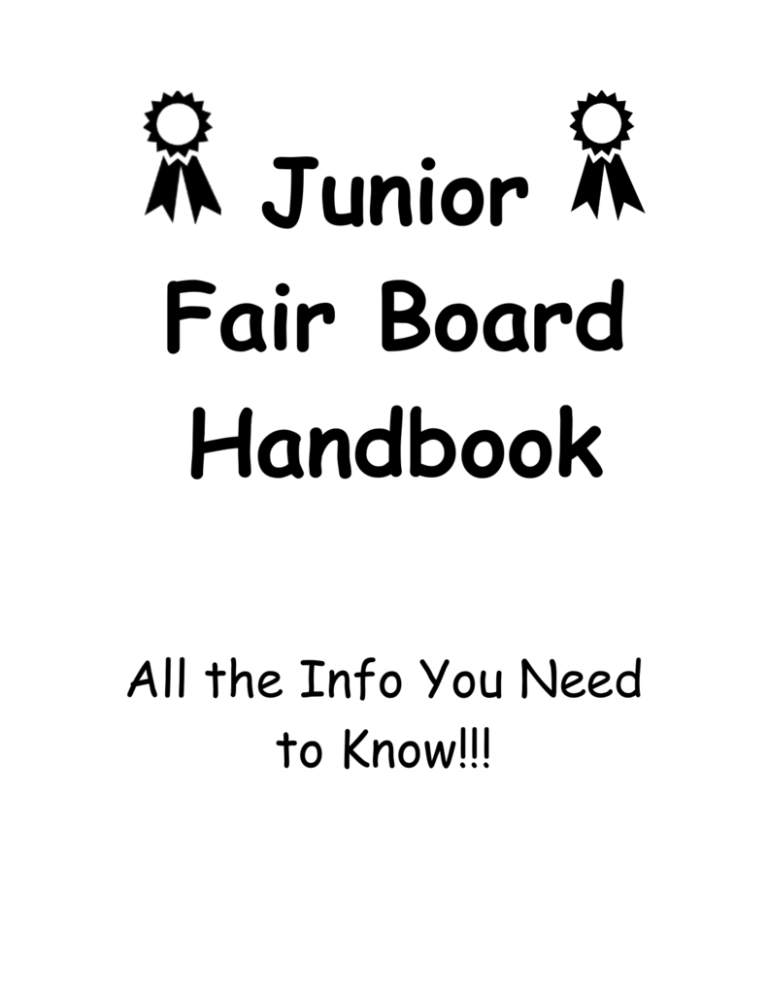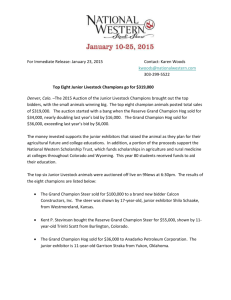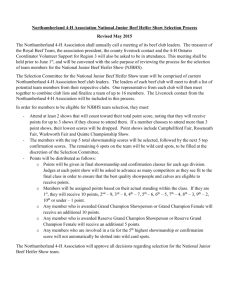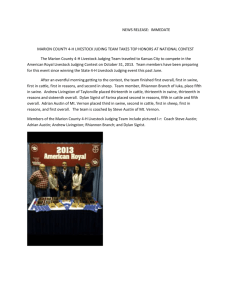Junior Fair Board Handbook - Indiana State 4-H
advertisement

Junior Fair Board Handbook All the Info You Need to Know!!! Important Junior Fair Board Activities and Dates Activity Date Pre-Fair Set-Up (Lunch provided) July 2, 9:00 a.m. – ?? Project Judging (Pizza Afterwards) July 3, 2:00 – 9:00 p.m. July 5, 2:00 – 7:00 p.m. Barth. Co. 4-H Fair July 6 - 14 Adventure Day Carnival June 11, 9:30 a.m. – 12:00 p.m. Kiwanis Dinner & Picture July 13, 5 p.m. Fair Clean-Up July 15, 2 p.m. Jr. Fairboard Dinner July 17, 5:00 p.m. Junior Fair board Code of Conduct As a Member of Bartholomew Co. Junior Fair Board I agree to uphold all of the rules and standings of the Bartholomew Co. 4-H and Indiana 4-H program. I will work to achieve the excellence that the 4-H program helps youth strive for. I will treat all 4-H members and volunteers with the respect that I wish to receive. I will set an example for the youth of Bartholomew County that shows respect, care, and assistance to everyone I come into contact with. I will be a trustworthy member of the 4-H volunteer network who takes pride in all of the activities of 4-H and the Fair. I will perform all of my duties with the diligence and attentiveness that they deserve. All of these things I will do for the betterment of the Bartholomew Co. 4-H program and community in which we reside. X___________________________ Sign Date Junior Fair Board Responsibilities Each Junior Fair Board member is REQUIRED to carry out the following Attend ALL Junior Fair Board Training sessions. (If a session can not be completed, member must arrange time to come into Extension office to obtain training.) Oversee at least one 4-H project. (Most members will have two.) Work at Pre Fair Cleaning and Set up. Work at Post Fair Clean-up. Work at community judging day, even if your project is not judged that day. Other Expectations of Junior Fair Board members Wear your Junior Fair Board shirt when working on Fair Board activities before and during fair week. This does not mean you have to wear it every day. Please wash between wears! Be on time to all events. We are working with numerous people’s schedules and you need to be available when needed. Be able to direct those with questions you are unable to answer to an adult volunteer or Extension staff member. Be a helpful and enthusiastic Role Model for 4-H exhibitors. They will be the future Junior Fair Board members! They look up to you; show them you care! Attend Kiwanis Dinner on the last Friday evening of the fair. Make sure to wear your Jr. Fair Board shirt, because we will be taking our group picture afterward! Assist fairboard members whenever possible. Help judging and other Fair events go as smoothly as possible! Behave in a manner that reflects the good reputation Junior Fair Board strives to maintain. X Sign Date Judging Day Duties Checklist Before Judging Set up station for judging. Make sure you have your Project book, fair book, enough chairs, tables, binders, placement cards, ribbons, tape, and pens. Wait at your station and greet judge. Tell about ribbon procedure and judging process. _______ Review and be familiar with all project guidelines and rules to help the judge with questions. For Each Project Check in each exhibitor in Project Book as they come in. Check each member’s Record sheets for completion and initial that you have reviewed. Give Judge the correct comment card for each project. Give placement ribbon to the exhibitor after the project is judged. Attach judge’s comment card to project with ribbon sticker on right corner of card indicating what ribbon the project received. During Judging Organize all blue star projects in one area for Champion and Grand Champion judging. Make sure judge always has everything he or she needs!!! (drink, snack, break) Do this OFTEN!!! Help judge during final judging by setting projects out for each division, grade, or category (depending on project) judged. After Judging Check books, make sure all information is filled out properly (county sheets, state fair entries, champion and grand and Parade of Champion’s sheet page). Ask judge to fill out comment sheet. Fill out Junior Fairboard Judge Evaluation Page. Turn in book to be checked. Judges check will be handed to you when judges book is correct. Help set up project display. Place the actual Champion and Grand Champion ribbons on the winning projects. Make sure they are secure. Make sure all cards and ribbons are visible. Clean up your area and help pick up building! GREAT JOB! Livestock Project Duties The Junior Fair Board member’s role with the livestock projects (beef, swine, dairy, sheep, goat, rabbit, poultry, cat, dog, and horse) is quite different than their roles with other projects. Therefore, it is important to know the differences and expectations for the livestock projects. Each livestock project has different dates for check-ins, weigh-ins, and judging. It is important to know the dates for your project and be present at all times needed. Each project has a Fair Board Superintendent who is in charge of the project and its judging. You will be working closely with the Superintendent. Make sure you ask what is expected of you and where you need to be when. The Superintendent is your biggest asset. It is also your duty to announce at the show. If you do not feel comfortable announcing, you may have your Junior Fair Board assistant(s) announce. It is your job to provide the announcer! Announcing entails: calling classes to the ring, announcing class placements, and assisting judge with microphone for their reasons. As announcer it is your job to introduce the judge at the beginning of the show and at least one other time throughout the show. You should speak with the judge prior to the event and get personal facts such as where they attended college, career, family, and where they reside. You also need to announce the donors of trophies and prizes during the selection of champions and grand champions. Be careful about what is said on the stand. The mic picks up a lot! Livestock judging events are quite hectic. While announcing it is also your job to keep track of class placements. These must be put into the Project Book just as in the other projects. You may keep track of placements on the show bill and transfer them to book afterward. Any complaints need to be handled by the Superintendent! Do not be afraid to turn questions over to them or the 4-H Youth Educator. Livestock Project Duties Checklist Before Judging Work at animal weigh-in and check-in (when applicable). Help with setting up and breaking classes (ask superintendent or 4-H Youth Educator). Make sure classes are posted and corrected (if needed) outside pavilion at least 1 hour before show. Set out enough ribbons for show. Set up trophy table. Help set up ring for show. Make sure you have enough pens and show bills at announcers stand. During Judging Introduce Judge. Announce (call classes to ring, tell class placings, trophy donors…). Keep track of exhibitor placings and ribbons given during show. Keep track of showmanship sign-up, break final classes, post showmanship classes, and announce the classes and indicate when Showmanship classes will begin. After Show Record all placings in Project Book. Help with ring clean-up. Return all extra ribbons to correct bins and clean-up announcer area. Junior Fairboard Need-to-Knows Project Records Project Records are records that the 4-H exhibitors fill out while they are working on their projects throughout the year. The record sheets on many of the projects are specific to the project and ask questions about the project. For example, with foods project records they may ask how many meals you fixed for your family in a month and what you prepared. Why and how to check Records We check records to make sure that the exhibitors are completing all of the parts of the projects other than what they are exhibiting. The way you check the records is by quickly reading over each page and placing your initials at the top of the record sheet for completion. If records are not completed or are not finished, tell exhibitor that they must finish their records before their projects can be judged. There will be extra record sheets for all projects by the kitchen office. Junior Fair Board Assistants Each Junior Fair Board Member is allowed one and sometimes two assistants to help during judging. The assistant is there to help organize and assist the fair board member whenever possible. You may divide up duties such as the assistant attaches all cards and places projects in correct categories while the Fair Board Member checks records, fills out the book, and assists the judge. Livestock Projects may need 2 or 3 assistants per project. What the different ribbons mean There are five main ribbons given out in most of the project judging. They are; Blue Honor (this group is pulled to judge for champion) Blue Red White Green (Completion) Most of the Projects will use Blue, Red, and White ribbons, but there are some projects that give each entry a completion ribbon. These projects also do not have champions or grand champions. They are only judged on completion. When a blue honor ribbon is given, the judge plans to consider the project for Champion, also known as a BLUE STAR RIBBON. A star sticker needs to be added to blue sticker on score card. 1 Champion and 1 Reserve Champion ribbon is given in each of the project divisions. There are varying amount of divisions between projects. 1 Grand Champion and 1 Reserve Grand Champion is chosen out of the champions. When the grand is chosen from the group of Division Champions, the Reserve Champion from the Grand’s division is brought up to be judged with the other Champions for Reserve Grand. State Fair Ribbons are given to those projects that the judge decides to advance to the state fair. Judges have the final say in which projects advance to the state fair. How the ribbons are given out The white, red, blue, and blue honor ribbons are given DIRECTLY TO the exhibitor after their project is judged. The Champions, Reserve Champions, Grands, Reserve Grands and State Fair ribbons are taped to the projects and put on display during the fair. State Fair Entries Many of the 4-H project areas exhibited at our fair are eligible for State Fair Entry. You can see if your project is by checking your Regulations and Rules to see if there is a State Fair Section, or if you have a state fair entry form in your Project Book. Each Project has a different number of state fair entries. Read over how many your project can send. Filling out the forms Checking in and Judging a project 1. Put an [X] in the exhibit box when project is brought up. 2. Put an [X] in the Record box once you have checked and initialed the record sheets. 3. On middle top line under Grade/Ribbon write what ribbon the Project received. Ex) Blue, White, or Red. 4. Put an [X] in the Honor group box if the project is awarded a blue star. 5. If project receives a champion or reserve champion, write it in under Award/Champion. State Fair Entries Inform Judge of how many Projects per division, grade, or category (depending on project) are eligible for the State Fair. Write name of Exhibitor in the Exhibitor’s name box for the correct division on the Indiana State Fair Form. If there is a Description of Project Box, place a brief description of the Project in box. Champions Page Once all champions, reserve champions, Grand Champion, and Reserve Grand Champion are chosen, simply write in the name of the 4-H exhibitor with the champion Project in the line beside their division, then fill in the name of the Grand and Reserve Grand at the top of the Page. ‘Closed’ Judging The selection of Grand Champion, Reserve Grand, and State Fair entries is a CLOSED judging process. This means that participants are not allowed to know the final outcome of judging until the Community Building opens on the First day of the Fair. If you have lingering watchers please inform them of the closed judging policy and ask them to come back on the first Friday of the Fair when the building opens at 5pm. Let’s do some PRACTICE!!! Exhibit Information EXAMPLE: Susie Q. is exhibiting a painting in Arts and Crafts General Crafts. She brought in her painting and you checked her record sheets for completion. The judge gave Susie a Blue Star on her Painting. Then, in Final Judging Susie received Reserve Champion in her division for her painting. See 4-H Judging Form to see how Susie’s Square should be filled in. Your Turn! Billy K. is exhibiting a desk he made for Woodworking. He brought in the desk and all of his records were completed. The judge gave Billy a Blue Star for his desk. Then in Final Judging he received Champion in the Senior Division, and Grand Champion Over all. Fill in Billy’s Exhibit Information. State Fair Entries Example: Mike Z. received a State Fair Entry for the Fossils he brought in for his Division II Geology Project. See Geology State Fair Entry for how to fill in Mike’s information. Your Turn! Mary D. received a State Fair Entry for her canned crushed tomatoes in Level C Preserved Foods. Her Tomatoes were in a glass jar with a green and white checked fabric on top of jar which matched her green recipe card.






